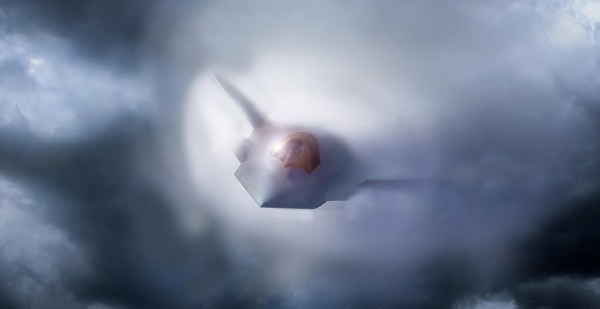Don’t expect ‘straight-line’ capability advancements for CCA drones, Air Force acquisition chief says

The capabilities of the Air Force’s next-generation drones — known as collaborative combat aircraft — are expected to increase over time, but that doesn’t mean there will be consistent leaps from one increment to the next, the service’s top weapons buyer told DefenseScoop.
The goal is to field the first tranche of CCAs by the end of fiscal 2028. The Air Force plans to spend more than $6 billion on related projects over the next five years.
“The whole idea of having increments of capability is that they are different. Now, they don’t … actually have to be a straight-line trajectory, right? Like, it’s not that every increment will necessarily be more sophisticated than the last … We see the potential for autonomy growing over time. But having said that … increments could just be focused on different operational problems and they may not necessarily be more or less advanced in like some kind of a straight-line trajectory,” Assistant Secretary of the Air Force for Acquisition, Technology and Logistics Andrew Hunter said in an interview Tuesday.
While the drones could carry a variety of payloads and play a variety of roles, air-to-air operations will be the main task of the first tranche, Thomas Lawhead, assistant deputy chief of staff for strategy, integration and requirements, has said.
The CCA program isn’t starting from square one in terms of technology development. The Air Force Research Lab has already planted seeds for the effort through its Skyborg vanguard project.
“This is the value, I would say, of the precursor work that AFRL did with Skyborg is because of the engagement with industry, and because of the engagement with our operational community, we were really able to look at a variety of concepts and figure out what really pays off in various operational scenarios and … what are the most essential attributes that are required to reach that objective to make that operational concept close. So that work that the foundation of the Skyborg effort laid, has really been very valuable as we’ve transitioned into CCA,” Hunter said.
The Skyborg work has been picked up by the program executive office for fighters and advanced aircraft, which is overseeing the next-generation air dominance and CCA projects.
Air Force could award production contracts to multiple companies for the first increment of CCA drones if there’s enough money for it.
Last week, Breaking Defense reported that five vendors are currently in the running for an early stage of the program — Boeing, General Atomics, Lockheed Martin, Northrop Grumman and Anduril.
During the interview with DefenseScoop on Tuesday, Hunter declined to discuss the number or specific companies that the service is working with right now.
However, when asked how many firms are capable of producing the types of drones that the Pentagon wants for the initial increment, Hunter said it’s “probably a larger number than folks might expect.” He confirmed that it’s substantially more than would be expected for a high-tech, manned fighter aircraft program. In the modern era, those efforts typically only have two or three prime contractors in the running.
“Our goal for CCA is continuous competition throughout the life of the program. So, you know, we’re not looking to ever skinny down to just one CCA manufacturer. Our expectation is we’ll have a range of CCA capability with continuous competition over time. And what we’re seeing at this stage is there’s enough capability in industry and there’s enough interest in industry to make that strategy viable. And so I’m very, very satisfied about that, very pleased about it,” he said.
DefenseScoop asked Hunter if the Air Force is looking at multiple manufacturers for the first increment of collaborative combat aircraft, which the Air Force hopes to field by the end of fiscal 2028.
He reiterated that the service wants continuous competition throughout the lifecycle of the program, adding that would include increment one.
In response to a follow-up question from DefenseScoop after the interview seeking clarification on whether Hunter was referring to potentially awarding production contracts to multiple vendors for increment one, an Air Force spokesperson provided the following statement: “The CCA acquisition strategy provides the flexibility to carry multiple vendors through the entire life cycle of the program. There are multiple decision points along the way and to the extent funding allows, multiple vendors will be involved for as long as possible.”
The Air Force is planning for a large arsenal of the next-generation drones and may acquire 1,000 or more. Secretary Frank Kendall has estimated that the unit cost will be roughly a quarter or a third of the price of an F-35 stealth fighter, enabling the service to increase capacity more affordably.
Hunter noted that the Air Force is using digital engineering processes to keep an eye on potential vendors.
“We’re leveraging digital engineering to the maximum extent that we can with today’s tools, which are pretty robust. What that means is that, throughout when you’re working with industry in a digital engineering context, right, the government has access to what industry is doing [and] industry has a lot more exposure to the government throughout the process. And so, we are able to evaluate and assess for those who are in our pool of vendors that we’re working with exactly where they are at any given point in time and assess their performance. So, we remain constantly aware of progress across the vendor base throughout the program,” the acquisition chief said.
The push for continuous competition isn’t limited to drone manufacturers. The Air Force also wants to apply that concept to software makers whose technologies will enable collaborative combat aircraft to operate autonomously and perform other tasks.
“In general, right, our philosophy is: Build a vendor pool of people with game in the space and, as I said, encourage continuous competition. So that’s our overall approach. It’s true of software as well, that we’ve already been able through Skyborg to have an initial vendor pool of providers who have demonstrated real capability — both on their own and working with AFRL — and transition those providers into the CCA program. And we will certainly be completely open to on-ramping additional providers over time. In fact, that is our plan,” Hunter said.
Although the Air Force is aiming to field CCAs in the next five years, the service won’t be cutting corners, he noted.
“Our focus on CCA is speed to ramp, and we’re looking to field a capability in the later 2020s … But it doesn’t mean we’re going to shortcut any of the necessary stages of the acquisition process. And when I say the acquisition process, I really mean the technology development, engineering and fielding process,” Hunter said.
“There are certain real engineering and technical tasks that need to be done in order to have viable, meaningful military operational capability. So, we’re going to do those things on CCA, we’re gonna do them with a great deal of discipline on making sure that the requirements that we set are ones that we think are achievable in the near term to meet our projected fielding date. And then we’re going to work through those in a rapid fashion to get there,” he added.
An engineering and manufacturing development effort will be needed.
“That will both enable us to confirm that we have technically achieved the military capability we were shooting for and also to do the development of manufacturing necessary to develop a production for capability,” Hunter said.
He wouldn’t say explicitly whether EMD is the next big step for the program.
“I don’t want to get into the timing. But it’s in there, you know, like Ragú. You know the old Ragú commercials,” he said cryptically.
Hunter declined to discuss the timing of specific contracting actions for the program.
Meanwhile, the budget impasse on Capitol Hill could throw a wrench into the program. Federal agencies have been operating under a continuing resolution since the beginning of fiscal 2024, which largely freezes funding for programs at the previous year’s levels and makes it harder to move forward with modernization efforts.
There’s a possibility that the Defense Department will be subject to a yearlong CR if lawmakers can’t reach an agreement on new funding.
“We would be substantially set back if there was a yearlong CR even on a program as high priority as CCA. And the reason is, we would be in crisis mode across so many parts of the Air Force portfolio that even top-level, you know, strategic priorities would be put under stress. The budget would be put under stress, because, of course, we will have an NDAA [policy bill for fiscal 2024] which will mandate, rightly and helpfully, a pay raise [for personnel]. So, you know, we will have to pay at the rate that is statutorily mandated … So, it would be exceptionally challenging to increase any program above its FY ‘23 level. In that scenario, in fact, the vast majority of programs obviously, by sheer math, would have to see a reduction even from ‘23 in order to make the budget work. So, it would definitely be a substantial delay to our efforts on CCA,” Hunter told DefenseScoop.
The Air Force’s fiscal 2024 budget proposal included $392 million for the main CCA budget activity line in fiscal 2024.
DefenseScoop asked Hunter if the service would request an “anomaly,” in DOD parlance, from Congress to free the program from the constraints of a yearlong CR.
“I think probably all of the services would need pretty substantial flexibility to move funds around in contrast to the FY ‘23 levels just for fact of life reasons, as I said, for the [military personnel] accounts. So, I think we would need robust flexibility across the portfolio. But certainly, we would not leave CCA out of whatever request we make,” he said.






